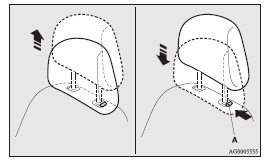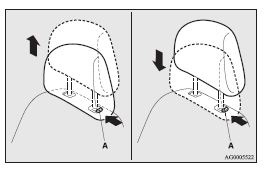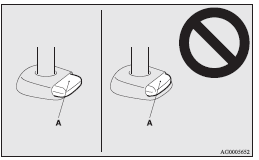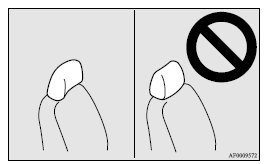Head restraints
![]() WARNING
WARNING
• Driving without the head restraints in place can cause you and your passengers serious injury or death in an accident. To reduce the risk of injury in an accident, always make sure the head restraints are installed and properly positioned when the seat is occupied.
• Never place a cushion or similar device on the seatback. This can adversely affect head restraint performance by increasing the distance between your head and the restraint.
To adjust height
Adjust the head restraint height so that the centre of the head restraint is as close as possible to eye level to reduce the chances of injury in the event of collision. Any person too tall for the head restraint to reach their seated eye level, should adjust the restraint as high as possible.
To raise the head restraint, move it upward. To lower the restraint, move it downward while pushing the height adjusting knob (A) in the direction of the arrow. After adjustment, push the head restraint downward and make sure that it is locked.

To remove
To remove the head restraints, lift the head restraint with the height adjusting knob (A) pushed in.

Installation
To install the head restraints, first confirm that they are facing the correct direction, and then insert them into the seatback while pressing the height adjusting knob (A) in the direction indicated by the arrow.
![]() CAUTION
CAUTION
• Confirm that the height adjusting knob (A) is correctly adjusted as shown in the illustration, and also lift the head restraints to ensure that they do not come out of the seatback.

![]() CAUTION
CAUTION
• The head restraints for the seats differ in shape and size. When installing head restraints, make sure the head restraints are fitted in their respective seats and do not install the head restraints in the wrong direction.

See also:
Front fog lamps (Type 2)
1. Remove the screw (A).
2. Pull the cover out in the direction of the arrow shown in the illustration.
3. Remove the screws (B) and pull the entire lamp unit out.
Note
► When unfaste ...
Manual reset mode
► When the average fuel consumption is being displayed, if you hold down the
multi-information meter switch, the average fuel consumption displayed at that time
is reset. ...
Audio system
Type 1- LW/MW/FM digital turning radio with CD player
Type 2- LW/MW/FM digital turning radio with CD changer
For information on operations of the audio system for vehicles equipped with
MITSUBIS ...
